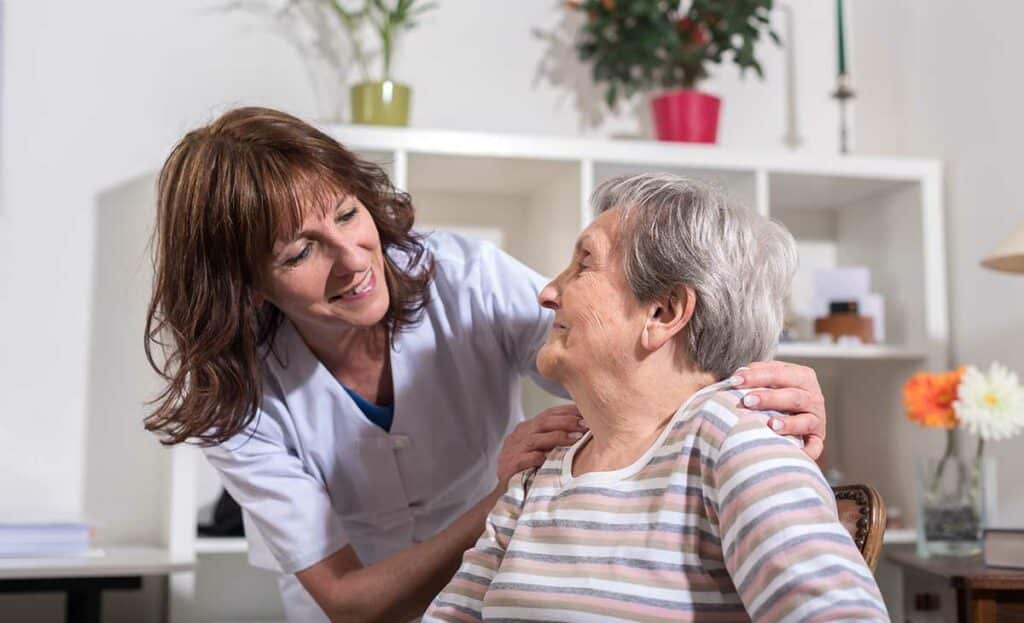Falls can be a major risk for our aging loved ones. As we age, our balance and strength can diminish, making us more vulnerable to falls and the injuries they can cause. Whether your loved one lives in a senior community or in their own home, a fall can be a life-changing event.
There are several steps you can take to help prevent your loved one from falling, such as:
- Recommending regular exercise
- Making their home more accessible
- Prioritizing proper footwear
- Consider using assistive devices
- Make an emergency plan
- Consider a move to assisted living
These options can help your loved one stay safe in their senior years, giving them an opportunity to feel safe and confident in their everyday life!
1. Recommend Regular Exercise
Regular exercise is crucial for seniors. It helps strengthen muscles, improve balance, and increase flexibility—all of which can reduce the risk of falls. Here are some low-impact exercises that are great for seniors:
- Walking: It’s simple, accessible, and can be done anywhere.
- Tai Chi: This gentle martial art improves balance and body awareness.
- Water aerobics: The water provides resistance for muscle strengthening and is easy on the joints.
- Yoga: It’s great for flexibility and balance, plus it promotes relaxation.
- Resistance band training
These low-impact exercises can help your loved one build muscle and joint strength to reduce their risk of falling.
2. Make Their Home More Accessible
If your loved one prefers to live at home, you might find yourself worried. What if it’s starting to get difficult to navigate their house safely? How easy is it for them to navigate the stairs or keep their footing on slippery surfaces?
Fortunately, there are many home modifications you can discuss to make their environment safer. Some modifications you might consider include:
- Installing grab bars and handrails—these can be placed in bathrooms, near the bed, or by the stairs to provide extra support
- Clearing floors of any potential trip hazards to reduce the risk of falls
- Improving lighting to help them navigate their home easily and safely
- Non-slip mats in the bathroom, kitchen, and other areas
- Removing rugs from walking areas, as they can be tripping hazards
- Rearranging furniture to create a clear path through every room
- Installing a ramp instead of stairs, if possible
By making modifications like these, you can make their home much safer and rest easy, knowing their home is easier to navigate.
3. Prioritize Proper Footwear
Many of us have a tattered favorite pair of shoes that probably should have been thrown out years ago. But for seniors, proper footwear is essential when the slightest slip or fall can lead to a life-changing injury. This makes it essential to take the time and get a pair of shoes that’s trustworthy and reliable.
When you’re looking into footwear, look for:
- Non-slip soles: Shoes with non-slip soles can provide extra grip and stability on various surfaces, reducing the risk of slips and falls.
- A proper fit: Shoes that are too tight or too loose can cause discomfort and instability. Ensure the shoes are the right size for the wearer’s feet.
- A supportive structure: Shoes should provide good arch support and have a sturdy back to help maintain balance.
- An easy-to-wear pair: Think about shoes with Velcro or slip-on designs that are easy for seniors to put on and take off without straining.
And maybe most importantly—comfort! Above all, the shoes should be comfortable and pain-free. Uncomfortable shoes can lead to issues like blisters and calluses that can make walking more challenging.
4. Consider Using Assistive Devices
As we age, it’s natural to need a little help getting around. Our bodies go through many changes in our later years, and sometimes it can be difficult to navigate the world like we did when we were younger.
That’s why assistive devices exist—so they can provide support and stability to give your loved ones the freedom to move about. Some options include:
- Canes
- Walkers
- Wheelchairs
- Motor scooters
- Transfer boards to help them get in and out of bed
You can even consider chair lifts for the stairs, grab bars in the bathroom, or extra railings.
5. Make an Emergency Plan
Even with all these precautions, accidents can happen. After all, you can’t always be around to catch your loved ones when they fall!
It’s important to have a plan in place for emergencies. Consider options like:
- Medical Alert Bracelets: These wearable devices display crucial medical information, which can be invaluable for first responders during emergencies.
- A GPS-enabled system to help your loved one get emergency care wherever they are
- In-home medical alert systems, like buttons on the walls or voice-activated speakers to call for help.

6. Consider a Move to Assisted Living
If your loved one’s needs are becoming too complex to manage at home, it might be time to consider a move to assisted living. At The Legacy at Forest Ridge, our team is here to provide assistance when needed, giving you peace of mind about your loved one’s safety, comfort, and quality of life.
Don’t wait until a fall occurs. Take action and book a tour with us today to get your loved one the care they deserve.
